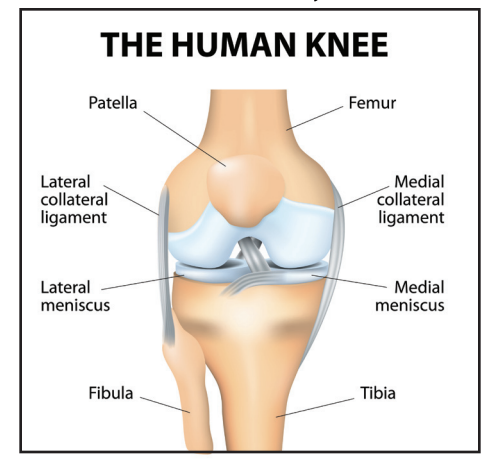
What is a knee sprain?
The knee has four main ligaments to help stabilize the joint. The ACL and PCL cross each other on the inside of the knee, while the MCL and LCL stabilize each side of the knee. The MCL is injured most often, followed by the ACL
What is the cause?
The risk is higher for elderly workers due to risks such as poor footing, awkward positioning, working at height, etc. Improper footwear, weak hamstrings and hip muscles, poor exibility in the quads and hamstrings, history of knee injury, and lack of muscle coordination are the primary causes of knee sprains.
The most common mechanism of injury is a quick forceful change of direction. This can occur with the knee and upper body moving in di erent directions or when the leg is stationary and the upper body moves forcefully in a di erent direction.
What are the signs/symptoms?
Typically, the employee will feel a “pop,” experience pain, have tenderness with bearing weight and notice swelling at the location of the sprain. If this happens at work, contact your supervisor as soon as possible. Our Athletic Trainer is trained to identify sprain, strains and fractures.
How can I manage this condition?
Common treatment for a knee sprain includes ice, compression wrap/bracing, elevation and ruling out fracture or other soft tissue damage.
Early diagnosis is critical, and RICE (rest, ice, compression and elevation) should be used right away. There is a risk that other structures (cartilage, bone, soft tissues) can also be a ected with a knee sprain, and this may require a referral for further analysis. Crushed ice in a plastic bag may be applied to both the inside and outside OR the front and back of the knee over a THIN layer of cloth. Icing with a cold pack for 20 minutes while elevated, every two hours for the first three days, can make the di fference between a fast versus slow recovery. Consult your Athletic Trainer as soon as possible if a sprain is suspected.
With appropriate care of a mild knee sprain, early movement and activity can be achieved immediately. In the case of a more severe sprain, function may be limited and full return to activities may take 2-3 weeks or longer.
How can I prevent a knee sprain?
- Use caution: Be aware of your footing environment and always look ahead before you step if you are not familiar with the job site.
- Strengthen: Muscles stretch, but ligaments don’t; strong hip and upper leg muscles support the framework of the knee.
- Avoid heat: Don’t apply heat or soak in a warm bath/hot tub if a knee injury is suspected. This will only increase in ammation.
- Don’t delay: Report injury of the knee right away. Primary care in the first few days are critical to a good outcome.


